The AMD Radeon R9 290 Review
by Ryan Smith on November 5, 2013 12:01 AM EST- Posted in
- GPUs
- AMD
- Radeon
- Hawaii
- Radeon 200
Power, Temperature, & Noise
As always, last but not least is our look at power, temperature, and noise. Next to price and performance of course, these are some of the most important aspects of a GPU, due in large part to the impact of noise. All things considered, a loud card is undesirable unless there’s a sufficiently good reason – or sufficiently good performance – to ignore the noise.
As we alluded to in our look at the 290’s build quality and AMD’s last minute specification change, while the 290 has great performance under the complete range of our gaming benchmarks, it’s with power, temperature, and noise that it has to pay the piper for that performance. There’s no getting around the fact that 47% on the 290 series reference cooler is going to be loud, and in this section we’ll break down those numbers and attempt to explain why that is.
First, let’s start with voltages. Ideally we’d use VIDs here, but due to the fact that none of our regular tools can read AMD’s VIDs for the 290 series, we’re left with what works. And what works is GPU-Z, which can read the VDDC coming off of the IR 3567B controller. These aren’t “perfect” numbers as we don’t have the ability to factor out fluctuations due to temperature or the impact of vDroop, but they’ll work in a pinch.
| Radeon R9 290 Series Voltages (VDDC/GPU-Z) | ||||
| Ref. 290X Boost Voltage | Ref. 290 Boost Voltage | Ref. 290 Base Voltage | ||
| 1.11v | 1.18v | 1.14v | ||
To that end you can immediately see that the 290 starts off in a weakened position relative to the 290X. Second tier products are a mixed bag in this regard as sometimes they’ll be composed solely of chips with damaged functional units that can be shut off and then downclocked to operate at a lower voltage, while in other cases they’ll also include chips that have worse leakage and power consumption characteristics. In the case of the 290 we have the latter.
As such the 290 is operating at a higher voltage than the 290X at both the base GPU clockspeed of 662Mhz, and the boost GPU clockspeed of 947MHz. This means at any given clockspeed the GPU on the 290 is going to be drawing more power – likely more than enough to offset the reduction from the disabled CUs – and furthermore we’re seeing that the voltage reduction from operating at lower voltages is not very significant. If these results are reasonably accurate then this means that the power costs of ramping up the clockspeed are relatively cheap, but the power savings of throttling down are relatively sparse. The GTX Titan, by comparison, sees a full 100mv decrease going from 940MHz to 836Mhz.
Having established that, we can see why AMD’s 7% fan speed increase had such a large impact on performance. Even a bit more cooling allows the card to jump to far higher clockspeeds, which significantly improves performance. With a fan speed of 47% the 290 has enough cooling to sustain 947MHz across everything except the TDP limited FurMark and Company of Heroes 2.
| Radeon R9 290 Average Clockspeeds | |||
| 47% Fan (New Default) | |||
| Boost Clock | 947MHz | ||
| Metro: LL |
947MHz
|
||
| CoH2 |
930MHz
|
||
| Bioshock |
947MHz
|
||
| Battlefield 3 |
947MHz
|
||
| Crysis 3 |
947MHz
|
||
| Crysis: Warhead |
947MHz
|
||
| TW: Rome 2 |
947MHz
|
||
| Hitman |
947MHz
|
||
| GRID 2 |
947MHz
|
||
With that out of the way, let’s dive into power, temperatures, and noise.
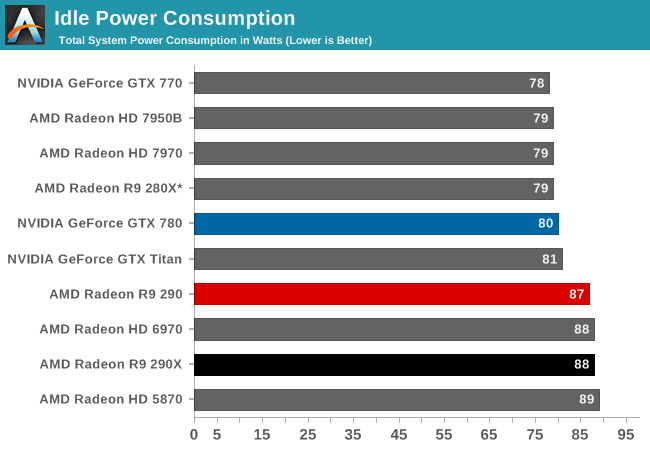
Idle power is essentially unchanged from the 290X. The 16 GDDR5 memory chips aren’t doing AMD any favors, but more significantly they appear to still have a power leak in their drivers at idle. Until they fix that, the 290 series will draw several watts more than any other modern single-GPU card.
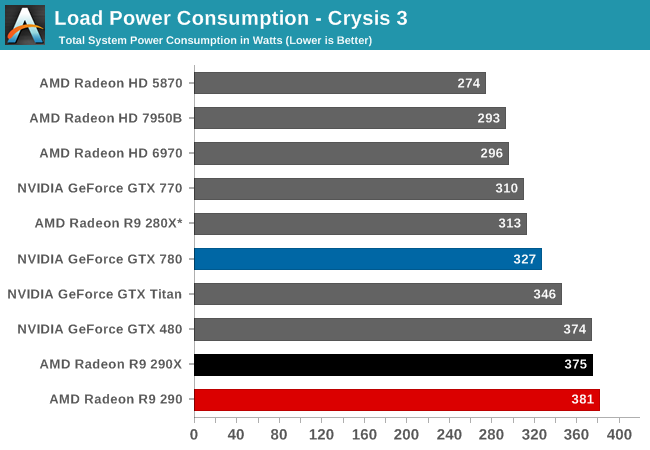
Moving on to power consumption under Crysis 3, we can see just how AMD’s TDP hasn’t changed compared to the 290X. In fact because these cards are effectively tied in performance in this game, we can even see at least some of the impact of the 290’s higher voltages. By operating at higher voltages in general, and then furthermore higher clockspeeds (requiring higher voltages), the 290 draws just a wee bit more power than the 290X under our gaming workload. Power efficiency wasn’t AMD’s strongest hand to behind with on 290X, and 290 makes it just a bit worse.
This also means that the 290 isn’t competitive with the GTX 780 on the matter of power consumption and power efficiency in general. A 54W difference at the wall for identical performance in Crysis 3 – or extrapolated over our complete benchmark suite a performance advantage of 6% – is very difficult to swallow. As with everything else to come for power, temp, and noise, the GTX 780 has a very real advantage here.
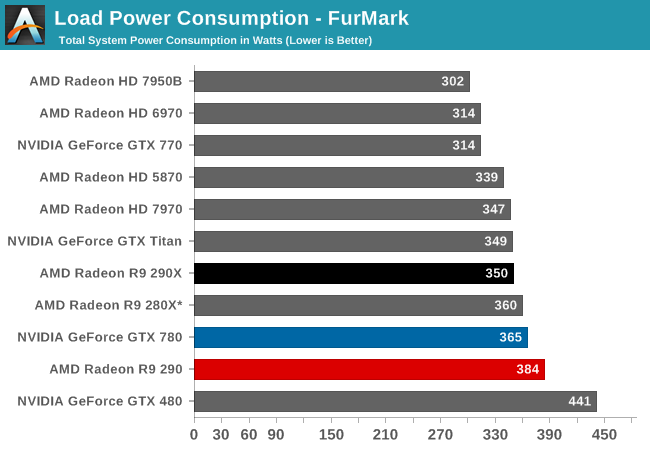
Moving on to FurMark, despite the fact that we should be TDP limited the 290 actually draws more power than the 290X. To be frank we’re at a bit of a loss on this one; 290 bottoms out at 662MHz here, so it may be that we’re seeing one of the things the card can do to try to maintain its base clockspeed. Alternatively this may be the voltage effect amplified. Regardless of the reason though it’s a very repeatable scenario, and it’s a scenario that has 290 drawing 34W more at the wall than 290X.
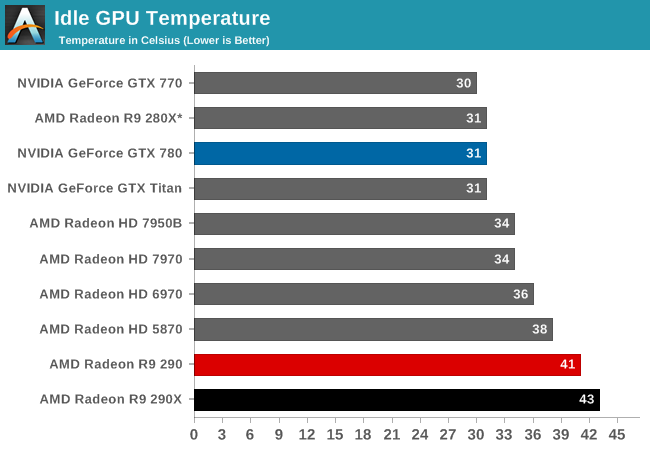
Given the fact that the 290 and 290X are built on identical boards, the idle temperatures are consistent, if not a bit more spread out than usual. Until AMD gets their power leak under control, Hawaii isn’t going to come down below 40C at idle with the reference cooler.
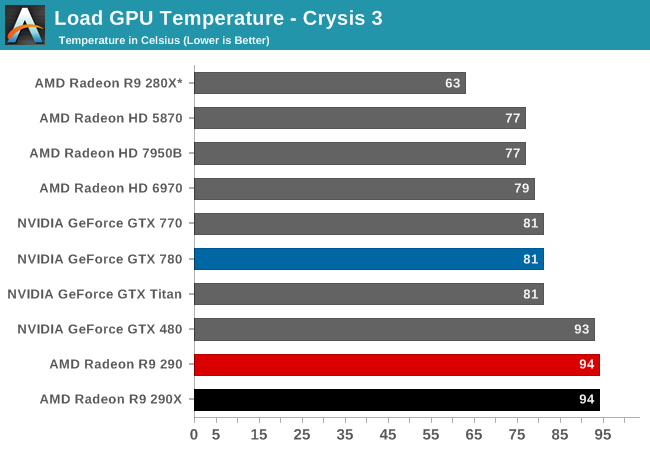
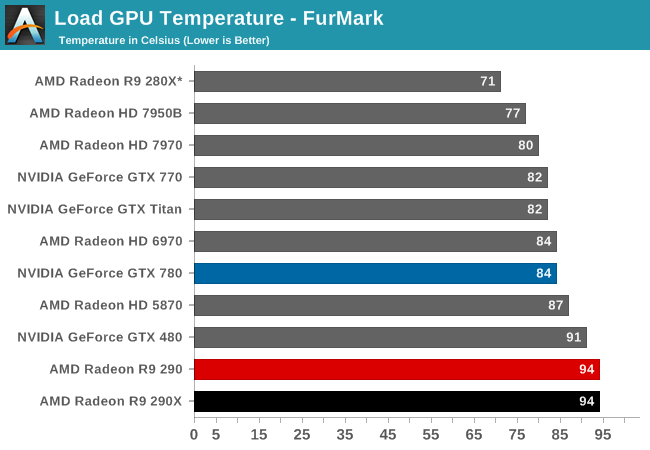
Due to the mechanisms of PowerTune on the 290 series, the sustained load temperatures for the 290 and 290X are a very consistent 94C. As we laid out in our review of the 290X these temperatures are not a problem so long as AMD properly accounts for them in their power consumption projections and longevity projections. But coming from earlier cards it does take some getting used to.
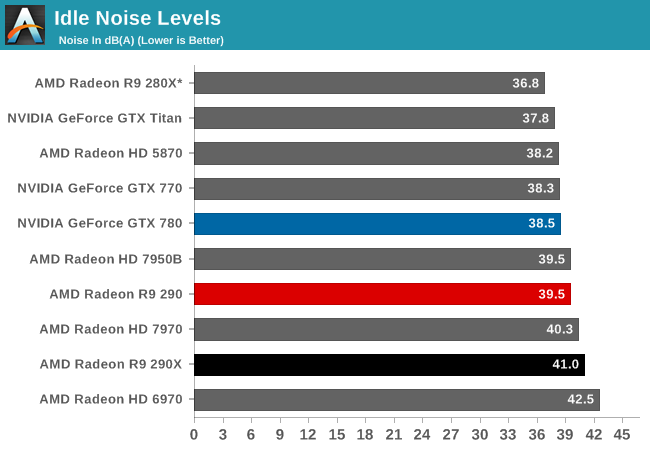
At last we have our look at noise. Starting with idle noise, we can see that the 290 actually outperforms the 290X to a meaningful degree, squeaking under the 40dB mark. The fact that these cards utilize the same cooler operating at the same fan speed means that these results caught us off guard at first, but our 290 sample for whatever reason seems to be slightly better built than our 290X sample. These results match what our ears say, which is that the 290X has a bit of a grind to it that’s not present on the 290, and consequently the 290 is that much quieter.
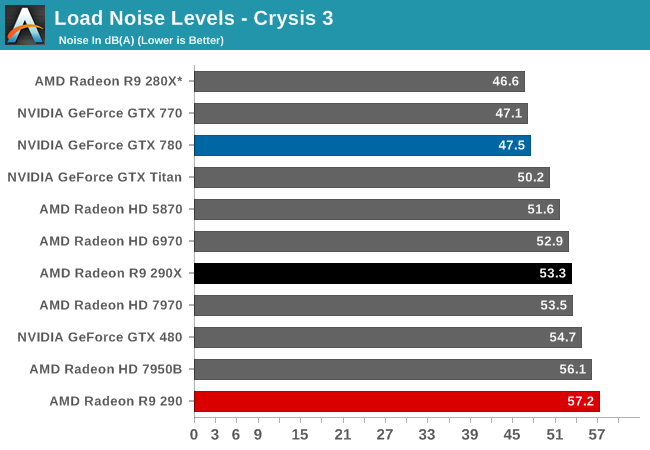
Our Crysis 3 noise chart is something that words almost don’t do justice for. It’s something that needs to be looked at and allowed to sink in for a moment.
With the 290 AMD has thrown out any kind of reasonable noise parameters, instead choosing to chase performance and price above everything else. As a result at 57.2dB the 290 is the loudest single-GPU card in our current collection of results. It’s louder than 290X (a card that was already at the limit for reasonable), it’s louder than the 7970 Boost (an odd card that operated at too high a voltage and thankfully never saw a retail reference release), and it’s 2.5dB louder than the GTX 480, the benchmark for loud cards. Even GTX 700 series SLI setups aren’t this loud, and that’s a pair of cards.
At the end of the day the 290 is 9.7dB louder than its intended competition, the GTX 780. With a 10dB difference representing a two-fold increase in noise on a human perceptual basis, the 290 is essentially twice as loud as the GTX 780. It’s $100 cheaper and 6% faster, but all of that comes at the very high price of twice the noise.
Everyone’s cutoff for a reasonable noise level for a single-GPU card is going to be different. Ours happens to be the 7970, which on our latest testbed measures in at 53.5dB. To that end the 290 is 3.7dB louder, putting it well past what we’d consider to be reasonable for the 290. It’s a powerful card, but these noise levels are unreasonable and unacceptable for any scenario that involves being able to hear the card while it’s working.
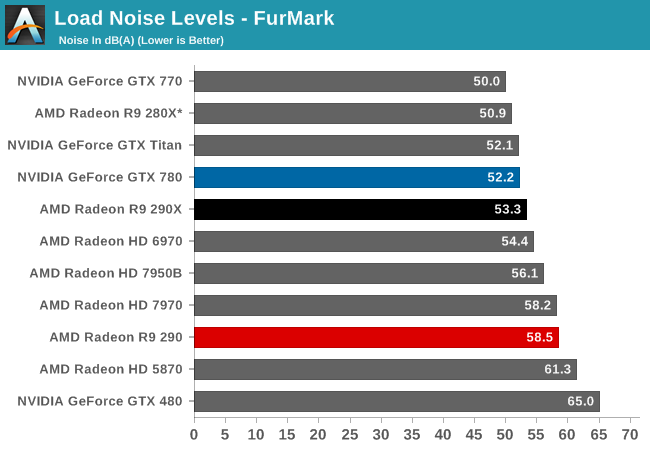
Finally we’ll look at noise under FurMark. As loud as the 290 is under Crysis 3, the 290 was only pushed to 45% fan speed under that workload. Under FurMark the 290 ratchets up to 47% and to its peak noise level of 58.5dB. Now to the credit of the 290 this does end up being better than the 5870 and GTX 480, but as neither of those cards implements modern power throttling technology it’s at best an unfair fight. Compared to any card with power throttling, the 290 ends up once more being the worst.
Wrapping things up, the power/temp/noise situation for the 290 is rather straightforward, but unfortunately for AMD it’s not going to be in their favor. 290 is at least marginally more power hungry and quite a bit louder than 290X, never mind GTX 780. As we’ve seen in previous pages the performance is quite good, but it comes at what will in most cases be a very high cost.
Finally, since we had a bit more time to prepare for the 290 review than we did the 290X review, we used part of our time to investigate something we didn’t get to do with the 290X: what would performance look like if we equalized for noise? Earlier in this article we took at brief look at performance if we equalized for noise against the 290X – the performance hit is about 12% - but how would the 290 fare if it were equalized to the GTX 780?
The answer is not well, likely for the voltage matters we discovered earlier in this article. To get a 290 down to ~48dB requires reducing the maximum fan speed to 34%, which is something AMD’s software allows. The problem is that at 34% the effective cooling level on the 290 is so poor that even after dropping to the base GPU clockspeed of 662MHz it still generates too much heat, requiring it to ramp up the fan speed to compensate. In other words it’s simply impossible to get the 290 to match the GTX 780’s noise levels under load. Based on our data the 290 requires a minimum fan speed of 38% to maintain its base clockspeed under sustained load, which pushes noise levels out from a GTX 780-like 48dB to a GTX Titan-like 50.9dB.
With that in mind, we went ahead and ran a selection of our benchmarks with the 34% maximum fan speed. The performance hit, as you’d expect, is significant.
| Radeon R9 290 Average Clockspeeds | |||||
| 47% Fan | 40% Fan | 34% Fan | |||
| Boost Clock | 947MHz | 947MHz | 947MHz | ||
| Metro: LL |
947MHz
|
830MHz
|
662MHz
|
||
| Battlefield 3 |
947MHz
|
870MHz
|
662MHz
|
||
| Crysis 3 |
947MHz
|
720MHz
|
662MHz
|
||
| Crysis: Warhead |
947MHz
|
662MHz
|
662MHz
|
||
| TW: Rome 2 |
947MHz
|
761MHz
|
662MHz
|
||
| GRID 2 |
947MHz
|
825MHz
|
700MHz
|
||

| Radeon R9 290 Relative Performance | ||||
| 290: 47% Fan Speed (Default) | 290: 40% Fan Speed | 290: ~34% Fan Speed | ||
| 100% | 88% | 78% | ||
To get down to the 34%-38% fan speed range, the 290 has to shed an average of 22% of its performance, peaking under a few titles at 25%. To be sure this makes the card much quieter – though not as quiet as a GTX 780 – but it also sacrifices much of the 290’s performance advantage in the process. At this point we’ve essentially reduced it to a 280X.
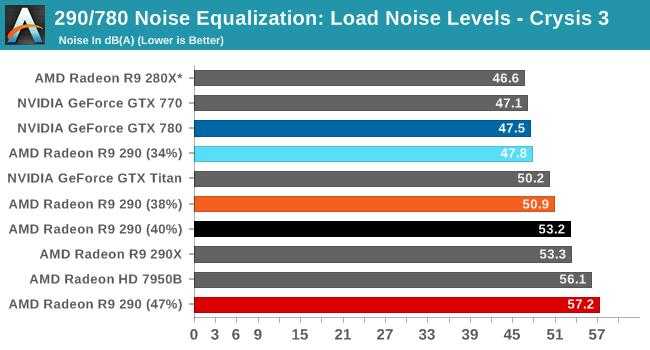
Looking at the resulting noise levels, you can see the full outcome of our tweaks. If we could sustain 34% we’d have a noise level consistently close to that of the GTX 780, but instead under Crysis 3 and a couple other games fan speeds level out at 38%, pushing noise levels to 50.9dB and placing them a bit higher than GTX Titan.
Based on this data it’s safe to say that the performance cost for using the fan control function to reduce the fan noise on the 290 will be moderate to severe. You can’t match GTX 780 or even GTX Titan, and doing so will reduce performance to that of a 280X. 40% on the other hand is more viable, but keep in mind we’re now at 290X noise levels for roughly 85% of the 290X’s performance, which isn’t a great outcome either.










295 Comments
View All Comments
TempAccount007 - Saturday, November 9, 2013 - link
What part of REFERENCE COOLER do you not understand?johnny_boy - Wednesday, November 13, 2013 - link
The IF isn't so big, I think. A lot of gamers already have blocks for their graphics cards, or don't care much about the additional noise, or want a block anyway at some point and the 290 presents an opportunity to get one now (and then cooling is quieter/better than the competing nVidia cards for the same price when figuring in the watercooling costs for the AMD card). I'd rather get the 290 (over the 780) and use my current watercooling solution. If I didn't have watercooling then I'd still rather buy the 290 and upgrade to watercooling.Eniout - Thursday, November 14, 2013 - link
my Aunty Julia recently got Jeep Compass SUV by working from acomputer. read the full info here www.Jobs37.coℳ
tgirgis - Thursday, February 20, 2014 - link
That's really extremely one sided, first of all, AMD already has a response to G-Sync, (their version for now has been dubbed "Free-Sync" but no idea if that nomenclature is final) and they have TressFX (which, at the moment, does look better than Nvidia's "Hairworks" but Nvidia will probably soon catch up), and they've got Mantle, which is definitely a massive advantage.Not to mention the R9 290 comes with 4GB Vram, as opposed to the GTX 780's 3GB, though it's really not a huge issue except in 4k gaming. Finally, shield compatibility isn't really a benefit, it's a $250 handheld game system, it's only beneficial if you interested in purchasing one of those, as opposed to being an included feature.
Nvidia is not without it's advantages however, they still have lower power consumption and thermals which is great for mini-itx systems (although manufacturer custom cooled cards can help bridge the gap for thermals) and they do still have Physx.
If Mantle keeps going the way it is now, Nvidia might be forced to pay royalties to AMD similar to how they did with Intel a few years back. If anything, AMD should throw "Allow us to use Physx" in the negotiations :)
slickr - Tuesday, November 5, 2013 - link
O yeah, Nvidia at this point has no choice, but to lower its prices again. I mean for $400 this card is amazing. It performs on the same level as the $1000 Titan and on the same level as the $550 290X, so a giant performance at a very cheap price.Even with the high noise(just wait 2 weeks for custom cooler) this card blows the GTX 780 out of the water, the performance is so much better.
I think if Nvidia wants to stay in the competition they would need to cut the GTX 780 price to at least $400 as well and try and get sales due to better acoustics and a lower power consumption, but if it was just performance in question they would need to lower the price of the 780 to $350 or 300 euros.
Of course that would mean that the 770 should get a price reduction as well and be around $270.
holdingitdown - Tuesday, November 5, 2013 - link
Yes this card is incredibly disruptive. The performance makes the 780 look like a mess. Expect to see at least another $100 slashed off the 780 and the 770 needs a little more taken off.The R9 290 is a monster!
crispyitchy - Tuesday, November 5, 2013 - link
Best card to release yet as far as I am concerned.The noise profile is not perfect, but every card is noisy once gaming to one degree or another.
What is perfect is the giant performance for this perfect price.
Newegg here I COME
Wreckage - Tuesday, November 5, 2013 - link
I doubt NVIDIA will cut their price. This card is so loud that most people will stay away and get a 780 or 770. AMD is so desperate to increase performance that they sacrifice everything else. It's like the last sad days of 3DFX.Da W - Tuesday, November 5, 2013 - link
Remember what happened after 3Dfx died? Higher price and mediocre performance.I'd buy AMD if only to keep them alive and force Nvidia to drop their prices.
HisDivineOrder - Tuesday, November 5, 2013 - link
Actually, traditionally, 3dfx was overpriced until the very end. ATI was always there competing with nVidia and 3dfx, anyway.So competition existed for as long as we've had discrete GPU's in any meaningful way. It's AMD that wants to end competition by standardizing PC gaming high performance around a GCN-based API only they can use meaningfully.